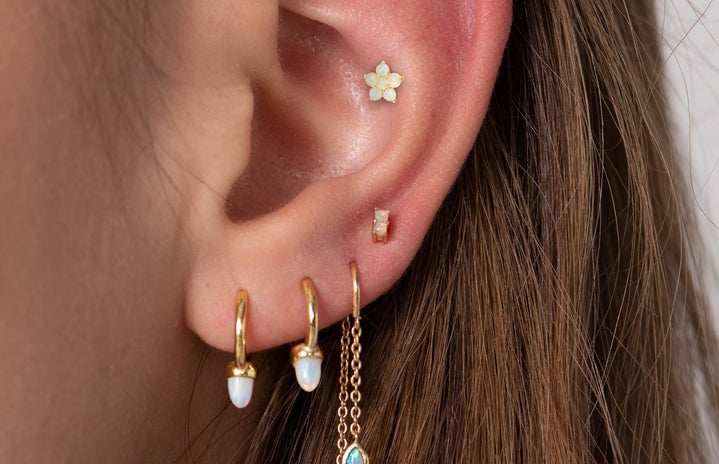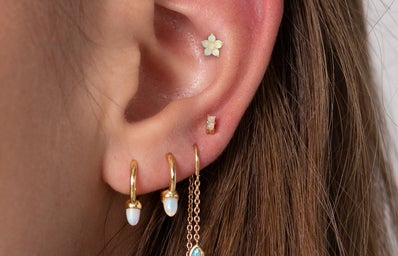Piercings have always been a favorite for body modifications. And why not? Getting a new piercing can be a fun way to update your look and express yourself! With dozens of possible combinations, piercing locations and types, a near-endless variety of jewelry, piercing is fun and customizable.
Although they are relatively easy to get and a lot of fun to have, there are many things to consider before getting a new piercing.
Find a Reputable Piercer
Today, there are hundreds of places that offer various body modifications, including piercings. However, not every location/piercer is created equal. Not to shame on certain chain piercing locations, but getting your ears pierced at a kiosk at a mall or department store may not be the best idea. Not everyone who works there is certified to pierce, or may lack experience with different ear shapes and anatomy.
Also, many tattoo parlors and other body modification salons and parlors offer ear piercing. But, just because they offer the service does not mean that they are good at it. Try to find a location that specializes in ear piercings, or has someone there who exclusively does the piercing procedure. You really want someone who knows what they are doing, as piercings are a monetary and time investment.
When looking for a good place, check out their reviews and piercing policies. Piercers who sterilize their equipment using UV sterilization, use needles instead of piercing guns, and have patient tables like they have at doctors offices (complete with the paper on top), are a better bet for safer sanitization. If lots of people are complaining about cleanliness in reviews or mentioning infection post-piercing, you might want to re-evaluate the location.
In addition, research is coming out that suggests that using piercing guns (as opposed to the hollow needle method) can damage cartilage and surrounding tissues, causing scar tissue. This is because the gun method forces a blunt object through the ear tissue, potentially shattering cartilage. This can cause problems with healing, extra pain, and even misshaping of the ear or droopy piercings. The hollow needle method, according to the Association of Professional Piercers, is safer and healthier for your body.
Good piercers will also examine your ears for the best place to put a new piercing and will help you make a new decision regarding piercing location if they think your original vision isn’t good for your body. For example, if your lobes are too small, a constellation piercing might not be the best idea.
Consider the Location Carefully
There are many different types of ear piercings available, and they all have slightly different care requirements. Also, they all have their own aesthetics. Feel free to mix and match! Just take time to consider their location. A good piercer will tell you whether or not a location will be good for your ears’ anatomy. Also, keep in mind that what works for one side, might not work on the other side, as our ears are not perfectly symmetrical.
When considering getting piercings higher up on your ears, consider how you wear your hair. For the healing process, you will want to keep your hair back to keep it from snagging or wrapping around the piercing. Keep in mind that during the pandemic, you might have to wear a mask while your piercing heals. It might take extra effort to keep your piercings from getting bumped or snagged.
Decide if you want piercings on both ears, if you want each ear to match, or if you’re okay with a different look on each side. Work with your piercer to curate a look that works with your body and your aesthetic. Whatever you choose, the finished look will be amazing and unique to you.
Understand that the Procedure is NOT Painless
But, it doesn’t cause earth-shattering agony either. It all comes down to where you decide to get your piercing. Generally, lobe piercings (the soft fleshy bit at the bottom of your ear) are less painful than cartilage piercing or gauges. This is because the tissue is softer there. In my experience, the pain is rather quick and feels like a very hot pinch. After the jewelry is placed, the area just feels tender for a while.
I have both cartilage and lobe piercings (two lobes on each side and a helix on each side). In my experience, the lobes were less painful than my cartilage piercings, however not by much. My lobe piercings almost felt like getting a vaccination or a small prick, whereas my cartilage piercings felt like a slightly longer hard pinch, with a bit of a burning sensation. I would say that the sensation was a little bit longer because of the mechanics of using a hollow needle versus a piercing gun.
I found that the second piercing of the session stung a little bit more. This is normal, as your body is already responding to a new object inside it, and is going to give you a stronger response to tell you to stop. Breathe deeply and relax, it’s over quickly. In my opinion, the brief moments of pain are worth a lifetime of sparkle.
After the piercing was done, I was given a saline rinse, which really soothed my ears, and the best part is, it’s just a solution of salt and water. You can buy it over the counter at drugstores and pharmacies.
Aftercare is a Process
Piercings are essentially open wounds and should be treated as such. Listen to your piercer’s aftercare instructions, but in general, expect to clean your piercings with wound wash/saline twice daily, avoid submerging them/swimming for the first few weeks of the healing process, and don’t sleep on them. It is important to clean them, and clean them well, as a build-up of bacteria or other materials like hair or fluff from your shirts can make the piercings irritated, and can cause infection.
Make sure to wash your hands before you clean the piercings, and avoid touching them or rotating them. Sleeping on the piercings can push them and make the holes crooked, and can also irritate them. Rotating the piercings can snag the tissue and put unnecessary stress on the wound, making the healing process longer.
Depending on the type of piercing, the healing time varies. It will also vary based on a person’s individual healing and body. My first set of lobes took 6 weeks to heal, and my second took 8 weeks to heal. Currently, I am still in the healing process for my helix piercings. According to my piercer, it should take three months for my ears to heal for jewelry downsize, and then an additional five months for full healing (a total of 8 months).
Getting a piercing is a healing commitment, because a new piercing will have to be guarded against snagging, cleaned, and avoiding pressure applied to the area (sleeping on them, over-ear headphones), for the entire duration of the healing process. You should also avoid changing the jewelry by yourself before the end of the healing period, and even for the first few months after you get them done.
Infections are Common
Even those who take care of their piercings the best they can, following all directions and such, can still get infections. Most infections clear up on their own, with the aid of saline rinses and keeping the area clean. However, prolonged infections, excessive swelling, or odd discharge can be a sign that something is wrong.
Our first instinct might be to remove the earring or to touch it/squeeze it, but that can make the infection worse, and can potentially spread it. Instead, leave the jewelry inside the piercing and contact your primary health care provider. However, if the infected piercing is a cartilage piercing, it is recommended that a doctor is seen quickly, via emergency care or urgent care, as cartilage piercings come with a few more risks than lobe piercings.
In most cases, with the help of prescription antibiotics and saline rinses, a piercing infection will heal and you can keep your jewelry in. Removing the jewelry can cause the piercing to close.
You Might Need a Jewelry Change
Depending on the type of piercing you get, you may need a jewelry downsize midway through the healing process. Usually, piercers start with a longer post than normal jewelry sizes to accommodate swelling. A downsize helps prepare the piercing for jewelry closer to the standard size, and keeps the jewelry fitting properly for good healing. Ask your piercing specialist if and when to come in for a downsize.
Also, keep in mind that jewelry changes usually come with additional expenses, for both the new jewelry and the change. Piercings are a process and can be expensive, so consider your price point before going in.
Most piercers recommend surgical grade titanium or a similar metal for new piercings, because they are the least likely to trigger an allergic reaction. Even metals we consider to be inert, like gold, can be irritating to new piercings, especially if the metal is just plated. Consider these factors when choosing jewelry for both your initial piercing and jewelry changes.
Eat Something Before Your Appointment
This seems like a no-brainer, but eating before your appointment is really important to keep your body comfortable during the process. Low blood sugar, or not having enough to eat, can cause a piercee to get light-headed or nauseated during the procedure. Try to eat a well-balanced meal with protein and vitamins at most four hours before your appointment time. Get hydrated.
Personally, I sometimes get lightheaded for no reason, so I brought someone with me to drive back home after the procedure in case I didn’t feel well. Make sure to read the piercer’s store policies before bringing a guest in with you. Sometimes guests are allowed, but often, they have to sit in a waiting room or in the car.
This is also a no-brainer, but arrive sober. Many piercers will refuse service if a person is under the influence of alcohol or drugs, and you don’t want your deposit to go to waste. It also is less likely to be a fun experience if you are not sober.
Most importantly, remember that piercings are supposed to be fun! Although there is a lot of information to consider, it is crucial that you get piercings because you want to. Remember that your piercer is there to guide the process and make it as safe and comfortable for you as possible. If for some reason, you are uncomfortable, say something! Really collaborate and relax.
Works Cited
“Aftercare.” Association of Professional Piercers, https://safepiercing.org/aftercare/.
“FAQ.” Association of Professional Piercers, https://safepiercing.org/piercing-faq/#1603500723311-9cb2fc90-03a5.
“Infected Ear Piercings: Causes, Symptoms, Treatment, Prevention.” Cleveland Clinic, https://my.clevelandclinic.org/health/diseases/21503-infected-ear-piercing.
“Issues with Piercing Guns.” Association of Professional Piercers, https://safepiercing.org/piercing-guns/.
“Jewelry for Initial Piercings.” Association of Professional Piercers, https://safepiercing.org/jewelry-for-initial-piercings/.
“Troubleshooting.” Association of Professional Piercers, https://safepiercing.org/troubleshooting/.


